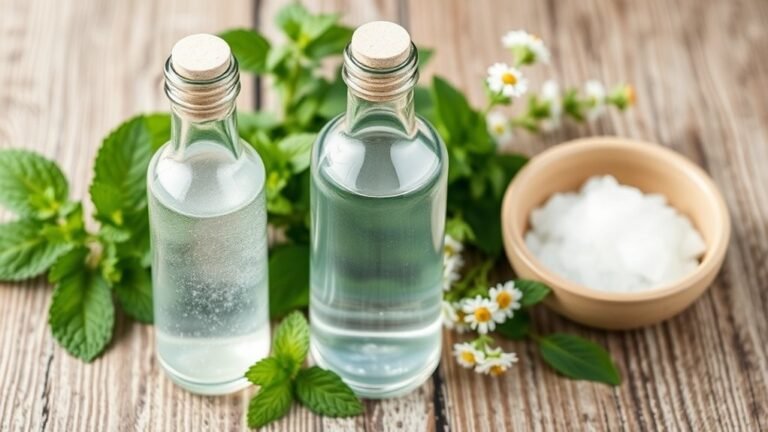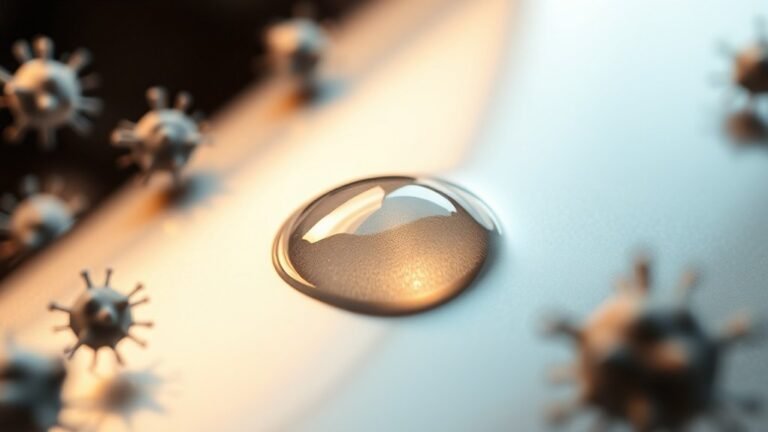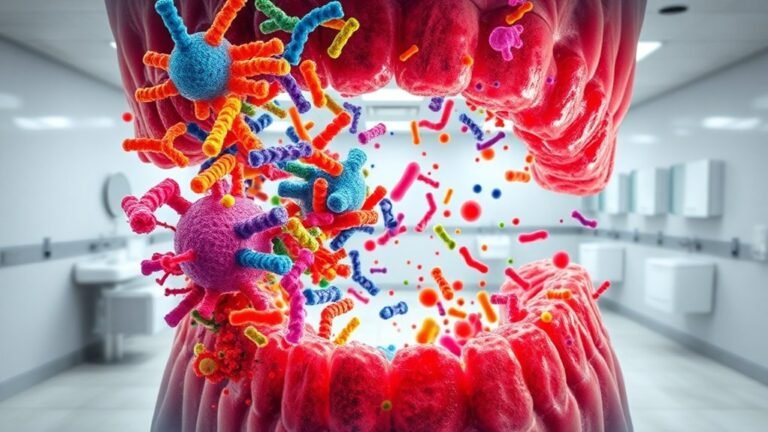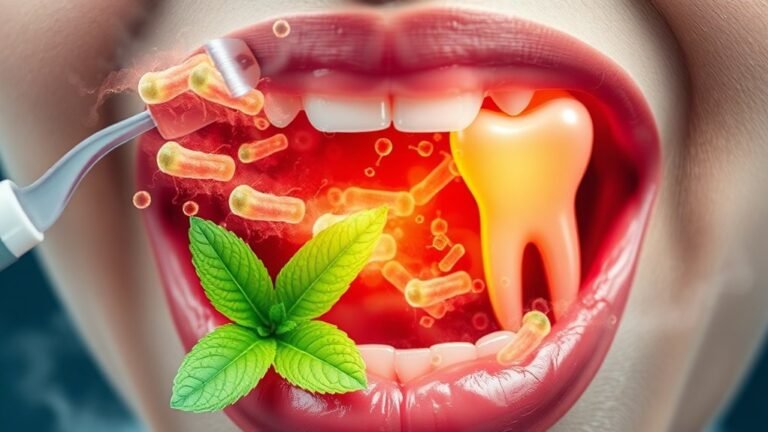Proper Brushing Technique Removes Plaque and Protects Against Cavities
To effectively remove plaque and protect against cavities, you need to master your brushing technique. Position your toothbrush at a 45-degree angle to your gum line and use gentle circular motions. Make sure to cover all surfaces of your teeth, brushing for two minutes twice daily. Using a soft-bristled toothbrush with fluoride toothpaste is key in preventing enamel erosion. To optimize your oral health, there’s much more you can learn about proper dental care practices.
Key Takeaways
- Position the toothbrush at a 45-degree angle to the gum line to effectively remove plaque.
- Use gentle circular motions to cover all tooth surfaces and minimize gum damage.
- Brush for two minutes twice daily to ensure thorough plaque removal and cavity prevention.
- Choose a soft-bristled toothbrush and fluoride toothpaste for optimal cleaning and enamel protection.
- Regularly replace your toothbrush every three months to maintain effective plaque removal.
The Importance of Proper Brushing Technique
While you may think that brushing your teeth is a simple task, mastering the proper technique is vital for maintaining ideal oral health. Effective brushing technique focuses on the right angle, pressure, and duration to guarantee maximum plaque removal. You should position your toothbrush at a 45-degree angle to your gum line, making gentle circular motions to dislodge food particles and bacteria. It’s important to cover all surfaces of your teeth, including the fronts, backs, and chewing surfaces. By doing this consistently, you enhance cavity protection and decrease the chances of developing dental issues. Remember, dedicating two minutes twice daily to practice this technique will greatly impact your oral health, leading to a brighter smile and healthier gums.
Understanding Plaque and Its Role in Cavities
Plaque is a sticky film of bacteria that forms on your teeth, and understanding its role in cavities is essential for maintaining your oral health. When plaque buildup occurs, it can lead to tooth decay, as the bacteria produce acids that erode your enamel. Effective tooth decay prevention hinges on regular brushing and flossing to remove dental plaque.
| Consequence of Plaque | Prevention Measures |
|---|---|
| Tooth Decay | Daily brushing |
| Gum Disease | Regular flossing |
| Bad Breath | Mouthwash use |
| Tartar Formation | Professional cleanings |
| Cavities | Diet management |
Recommended Toothbrush and Toothpaste Choices
Choosing the right toothbrush and toothpaste is essential for effective oral hygiene. Opt for a soft-bristled toothbrush to minimize tooth sensitivity while still providing adequate plaque control. A brush with a small head can reach those tricky areas in your mouth more easily. When it comes to toothpaste, look for fluoride options, as they strengthen enamel and help prevent cavities. If you have specific concerns, like sensitivity, choose a toothpaste designed for that purpose. Regular brushing frequency—at least twice a day—is vital to maintaining your oral health. Remember, the combination of the right toothbrush and toothpaste, paired with consistent brushing, plays a significant role in effectively removing plaque and protecting your teeth from cavities.
Step-by-Step Guide to Effective Brushing
To achieve effective brushing, start by selecting the right toothbrush that suits your needs. Once you’ve made your choice, focus on mastering the circular motion technique for ideal plaque removal. This approach not only enhances your oral hygiene but also contributes to overall dental health.
Choose the Right Toothbrush
Selecting the right toothbrush is essential for maintaining ideal oral health. When choosing a toothbrush, consider the bristle type—soft bristles are generally recommended for effective plaque removal without damaging your enamel. The size of the brush head also matters; a smaller head can reach difficult areas, improving your overall oral care routines. Additionally, you may opt for an electric toothbrush, which can enhance plaque removal and make brushing easier. Always check for the American Dental Association (ADA) Seal of Acceptance to guarantee quality and safety. Remember, selecting the right toothbrush not only aids in plaque removal but also contributes to enamel protection, paving the way for a healthier smile. Prioritize this choice to boost your oral hygiene effectively.
Master the Circular Motion
Mastering the circular motion while brushing your teeth is essential for effective plaque removal and overall oral health. This technique not only enhances your dental hygiene but also minimizes cavity risk. To master the circular motion, follow these steps:
- Position your toothbrush at a 45-degree angle to your gums.
- Use gentle, circular movements, ensuring you cover all tooth surfaces.
- Spend at least two minutes brushing, dividing your mouth into quadrants.
- Rinse and check for missed spots, ensuring thorough plaque control.
Common Brushing Mistakes to Avoid
Many people unknowingly make common brushing mistakes that can undermine their oral health. One major error is brushing too aggressively, which can damage your gums and enamel, leading to increased exposure to oral bacteria. Additionally, neglecting to replace your toothbrush every three months can result in ineffective cleaning, allowing bacterial plaque to build up. It’s also essential to brush for at least two minutes, as rushing through can leave plaque behind, putting your gum health at risk. Another mistake is failing to clean the tongue, where bacteria can thrive. Finally, using a hard-bristled toothbrush may feel effective, but it can harm your gums. By avoiding these pitfalls, you’ll enhance your brushing technique and maintain better oral health.
The Benefits of Regular Dental Check-ups
While you might think that brushing and flossing are enough to maintain your oral health, regular dental check-ups play a crucial role in preventing serious issues. These appointments guarantee your teeth and gums stay in top shape, allowing for professional dental cleaning that removes plaque and tartar buildup. Without regular visits, you risk gum inflammation and more severe dental problems that could threaten your smile.
- Early detection of cavities
- Prevention of gum disease
- Customized oral health advice
- Enhanced overall well-being
Additional Tips for Maintaining Oral Hygiene
To maintain ideal oral hygiene, it is important to incorporate a few key practices into your daily routine. Flossing daily helps remove plaque and food particles from between your teeth, while using mouthwash regularly can enhance breath freshness and provide additional protection against germs. Additionally, don’t forget to replace your toothbrush every three to four months to guarantee effective cleaning.
Floss Daily for Health
Flossing daily is essential for maintaining ideal oral health, as it removes plaque and food particles from between your teeth that a toothbrush often misses. This vital step helps promote bacteria control and supports a balanced oral microbiome, reducing your risk of cavities and gum disease.
By incorporating flossing into your daily routine, you can experience:
- A brighter smile that boosts your confidence
- Fewer dental visits due to reduced plaque buildup
- Improved breath that makes social interactions more enjoyable
- Long-term savings on dental treatments
Make flossing a priority; it’s a simple yet powerful way to take control of your oral health and guarantee your smile stays healthy for years to come.
Use Mouthwash Regularly
Incorporating mouthwash into your daily oral hygiene routine can greatly enhance your overall dental care. Mouthwash serves as an effective tool for tartar prevention, helping to reduce plaque buildup and freshen your breath. Choose an alcohol-free mouthwash that contains fluoride to strengthen your enamel and promote healthier gums.
In addition to commercial options, consider natural remedies like saltwater or herbal rinses, which can also provide antibacterial benefits. Using mouthwash after brushing and flossing can flush out remaining debris and bacteria, ensuring a more all-encompassing clean. Aim to use mouthwash at least once a day, preferably before bedtime, to maximize its protective effects. Consistent use will contribute considerably to maintaining your oral health and preventing future dental issues.
Replace Your Toothbrush Often
Maintaining a robust oral hygiene routine goes beyond just using mouthwash; replacing your toothbrush regularly is another essential aspect. A worn-out toothbrush can’t effectively remove plaque, which may lead to cavities and gum sensitivity. To keep your smile healthy and support your immune system, consider these tips:
- Replace your toothbrush every three to four months.
- Switch it out sooner if the bristles fray or show signs of wear.
- Consider brushes that promote oral probiotics for added protection.
- Don’t forget to clean your toothbrush holder regularly to minimize bacteria.
Investing in a new toothbrush not only enhances your oral hygiene but also contributes to overall health. Make it a habit, and your mouth will thank you!
Frequently Asked Questions
How Often Should I Replace My Toothbrush?
You should replace your toothbrush every three to four months, or sooner if bristles fray. Regularly changing it helps maintain effective cleaning and prevents bacteria buildup, ensuring your oral hygiene routine remains effective and healthy.
Can Certain Foods Help Reduce Plaque Buildup?
Yes, certain foods can help reduce plaque buildup. Crunchy fruits and vegetables, like apples and carrots, stimulate saliva production, which naturally cleans your teeth. Dairy products also promote healthier gums and stronger enamel, aiding plaque reduction.
Is Mouthwash Necessary After Brushing?
While mouthwash isn’t strictly necessary, studies show that using it can reduce plaque by up to 20%. You’ll benefit from additional protection against bacteria and fresher breath, enhancing your overall oral hygiene routine.
How Long Should I Wait to Eat After Brushing?
You should wait at least 30 minutes after brushing before eating. This allows the fluoride from your toothpaste to strengthen your enamel, maximizing its protective benefits and ensuring your teeth remain healthy throughout the day.
Can Children Use Adult Toothpaste?
Sure, kids can use adult toothpaste, but it’s usually best to stick to fluoride-free options for younger ones. Adult toothpaste can be too strong, potentially causing stomach upset if swallowed. Always supervise their brushing!
Conclusion
By mastering proper brushing technique, you’re not just fighting plaque—you’re wielding a superhero cape against cavities! Always choose the right toothbrush and toothpaste, and follow the effective brushing steps to maximize your oral health. Don’t forget to schedule regular dental check-ups, as they’re essential for maintaining that dazzling smile. Remember, consistent care leads to a lifetime of healthy teeth, so commit to these practices and watch your dental health soar to new heights!






